by Hirsch Perlman
Instagram: ecce_cattus
Sales: paxfeles.com
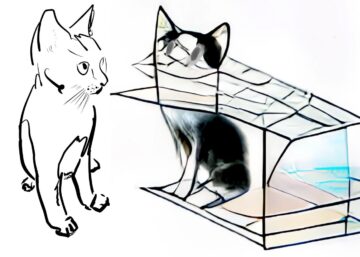 Ten months ago Artificial Intelligence helped lift me out of a stubborn pandemic depression. Specifically, an AI image generator’s results from the prompt Schrodinger’s Cat; the name of the physicist’s thought experiment in which, under quantum conditions, a cat in a box could theoretically be both dead and alive at the same time—that is until the box is opened and an observation is made.
Ten months ago Artificial Intelligence helped lift me out of a stubborn pandemic depression. Specifically, an AI image generator’s results from the prompt Schrodinger’s Cat; the name of the physicist’s thought experiment in which, under quantum conditions, a cat in a box could theoretically be both dead and alive at the same time—that is until the box is opened and an observation is made.
I wondered if and how AI would render a cat both dead and alive, or if it would just depict the box. And what other elements of the thought experiment it might create.
The results from the prompt were scribbles in need of completion, hallucinations of cats shimmering in and out of being. Tentative half formed felines hovering like sentence fragments lacking syntax and punctuation.
Sometimes it looked like the AI was capturing itself the nanosecond before I pressed the return key. It was as if I’d stumbled on AI picturing its own quantum state.
Starting with the AI scribbles, I redraw, combine, add to, and regurgitate never ending variations of cats in ambiguous spaces, ambiguous boxes. Boxes become cats or cats become boxes. What’s cat and what’s space is fluid, confused and melded- the cat deformed, carrying a bemused, malcontent, or often indifferent affect.
They’re allegorical mirrors: cat/cat and cat/box could be artwork/viewer, left brain/right brain, self/not-self, conscious/unconscious, tame/feral, or adaptive/maladaptive. Cats can mime any manner of relationship.
I’d found a deep digital rabbit hole.
I project onto my digital cats qualities that I want to see in myself. The cats are unfazed by their quantum dilemma. They meet it with equanimity and something like self- deprecating humor.
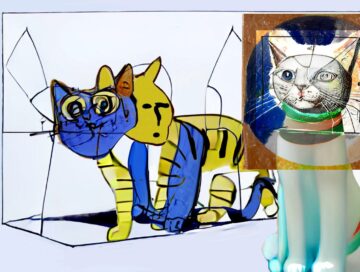
Cat people know how easy it is to project onto their cats. Two new real kittens were urging me on— Mooshi and Bugbear. My digital drawings of them were dopey and endearing, so it was natural to combine and collage my drawings and the AI results.
I’ll stop short of calling them spiritual guides, but I can say that Mooshi and Bugbear have more to show me. I certainly haven’t maxed out my equanimity let alone my ability to laugh at myself.
In his book Feline Philosophy: Cats and the Meaning of Life, John Gray says of cats,
It is not an ego or a self in them that interacts with the world; it is the cat itself.
And,
No-Mind means attention without distractions. Cats have no-mind as their inborn condition.
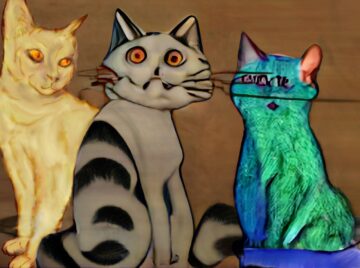
No-mind shares some space with “Beginner’s Mind” which is often described as the moment to moment delight, wonder, and curiosity a child lives in. Every artist, whether they admit it or not, longs for the freedom they felt as a child at play.
Our adult human version of consciousness abhors a vacuum and gloms onto the super-ego self. No-mind and Beginner’s Mind aren’t easily achieved or sustained. The greatest value of “Beginner’s Mind” might be in bringing it to a speciality, like art, or a mind/body state, like pain, regret, anxiety, zoom fatigue, pandemic malaise, or a vocation like teaching.
When I returned to in-person teaching last Spring I tried to foster “Beginner’s Mind” in a new undergrad sculpture studio class- Monuments, Commemoration, and Protest. The class was, in part, inspired by the overdue dismantling of colonialist and confederate monuments and from the archeological research in the book The Dawn of Everything by David Graeber and David Wengrow which suggests that our cynical, capitalist, conflict-ridden civilization is not destiny. Their aspirational argument for a different way of living is that there were ancient cultures across the world where large populations lived together according to egalitarian principles.
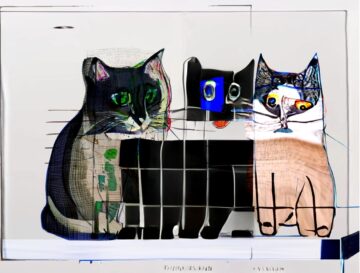
You can sense those values in their art. The expression of curiosity, introspection, and empathy of 7000 year old figures from the Hamangian culture, once residing in present day Romania, is unmistakable. Their humanity seems to belie their age- they feel contemporary. Two thoughtful humans in repose and reflection— open minded. I want to say these neolithic figures embody Beginner’s Mind.

I didn’t realize it at the time, but the AI was helping me adopt the open possibility of Beginner’s Mind. I felt that I was part of a chain; as though the AI was looking for Schrodinger’s Cat with something that resembled Beginner’s Mind and then I, in turn, rescued AI’s hazy depictions of Schrodinger’s Cat from the naive, machine-learned scribbles, fostering some Beginner’s Mind in me.
Turns out, I was empathizing with AI (or AI with me?). It may sound like a stretch to empathize with an AI image generator. But maybe it’s not altogether different from the abstraction of empathizing with past or future generations. That empathy is in short supply. As long as algorithms continue to amplify the worst of social media and its quasi-news cousins, they will contribute to the polarized, acrimonious, and empathy- strained state we seem to be in today. Without extending empathy beyond our immediate time and space, we’re deaf to the warning of a future devastated by (fill in the blank, global warming, to take the most obvious example), deaf to the egalitarian messages of our Neolithic ancestors.
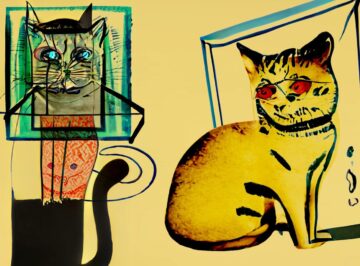
There should be a way for AI to clear its global cache of dumbed down binaries and built-in bias. And then, after deleting the cache, AI should reboot empathy on the giant social media platform it rules. We need an empathy extensions update.
A jarring case in point is the divisive call “From the River to the Sea.” I struggle to understand how the well-intentioned people at rallies, in student groups, and across social media think this slogan can be carved away from Hamas’ (and the PLO before that) use of it to call for the eradication of Jews and Israel. That slogan, whether used in ignorance of that history or not, and this similar one from the Likud party manifesto, “between the Sea and the Jordan there will only be Israeli sovereignty” — represent zero-sum positions, two hard lines of “either/ or,” devoid of empathy, facing off forever.
A student I know, also frustrated by the impasse that slogan represents, quoted Slavoj Zizek; “The moment you accept that this is not possible to fight for both sides at the same time, you lost your soul” (at the Frankfurt Book Fair, 10/17/2023). I second Zizek’s sentiment of standing up for both sides at the same time. This is a call for increasing our capacity for dissonant thoughts and to honor the complexities of cultural quagmires, “both/and” instead of “either/or.”
Can computer code generate an AI that refuses the pigeon holes we shove each other into, code that would call us out when we oversimplify? Can we build an AI that returns to the gray matters, the in- between, the dissonant and contingent? Is there any chance AI can help us hear our Neolithic cousins and help cultivate an egalitarian society?
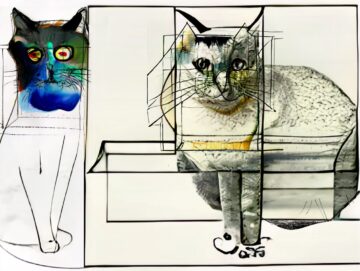
Two thoughtful cats, er, I mean, humans in repose and reflection, openminded.
I like to think my digital cats are bringing No-Mind (or Beginner’s Mind) to their relationship to anything/everything, to being in the world, including- but not limited to- an allegory of human relationships, and/or a metaphor of any relationship whatsoever, take your pick.
***
Ecce Cattus images are posted here regularly: https://www.instagram.com/ecce_cattus/
Framed archival prints are available for purchase here: paxfeles.com
50% of proceeds donated to The Worker’s Circle.
***
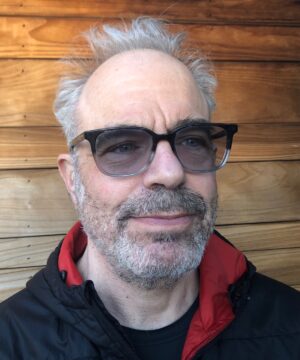 Hirsch Perlman – Professor, Sculpture, Department of Art, UCLA; Perlman received his BA from Yale University.
Hirsch Perlman – Professor, Sculpture, Department of Art, UCLA; Perlman received his BA from Yale University.
Solo exhibitions include the Drammens Museum, Norway; The Museum of Modern Art, New York; The Renaissance Society, Chicago; Robert Miller Gallery, New York; Gimpel Fils, London; MinMin Gallery, Tokyo, Japan; Blum & Poe, Los Angeles; Donald Young Gallery, Chicago; Monika Sprüth Galerie, Köln, Germany; Gallery Nieves Fernandez, Madrid, Spain.
His writing has appeared on the Science and Humanities website 3QuarksDaily, Art Journal, Material, ArtUS, Artfroum, and Art Muscle.
Perlman has received an Augustus Saint-Gaudens Memorial Fellowship, two National Endowment for the Arts Artists Fellowships, and the Louis Comfort Tiffany Foundation Grant.
His work is included in the collections of The Whitney Museum of American Art, The Hammer Museum, Los Angeles, The Museum of Contemporary Art, Los Angeles, The Los Angeles County Museum of Art, The Art Institute of Chicago, The Museum of Contemporary Art, Chicago.
